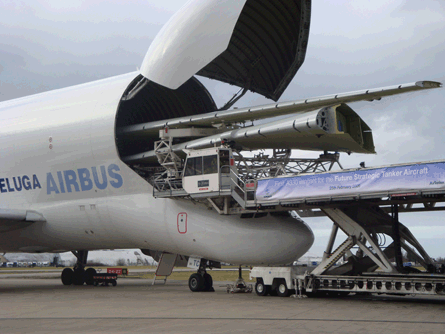The headlines may be being dominated by Airbus A380 service introductions and rival Boeing's ongoing travails with 787 production, but behind the scenes the engineering effort to bring the European manufacturer's most important new programme to the market on time is reaching its peak.
The A350 XWB family - entry into service of which is planned for 2013 - represents Airbus's challenge to the increasing dominance of the Boeing 777, and the US manufacturer's impressive early sales success with the smaller 787.
CRITICAL TO SUCCESS
Critical to the success of the A350 is the wing, being designed, developed and assembled in the UK, like all Airbus wings before it. The difference this time is that the wing is being constructed almost entirely from carbonfibre reinforced plastics (only the wingbox ribs are metal), and using a new "pulsing" production line concept.
 |
|---|
© Airbus |
The success of the A350 in the marketplace has meanwhile led Airbus to attempt to ramp up production from zero to 13 aircraft a month at twice the rate of that achieved for the much smaller A320 narrowbody. Over the first five years of production, 112 A320s were rolled out of the factory, but A350 output is projected to be 236 aircraft over the equivalent time period.
PUSHING BOUNDARIES
"I wouldn't have believed some of the technology, and how we have moved A350 manufacturing on compared with the A380," says Airbus head of wing centre of excellence Brian Fleet. "We've pushed the boundaries significantly further compared with anything we've done before."
GKN factory GKN Aerospace is preparing a dedicated factory to build Airbus A350 composite wing spars and trailing edges in a former warehouse building 8km (5 miles) from the Filton manufacturing plant it bought from Airbus in January. Development hardware will be installed in March or April, and the plant will ultimately house five of the world's biggest automated carbonfibre laying machines to be capable of turning out 90 of the 20m (65ft)-long wing spars a month for shipment to Airbus's Broughton plant for assembly. Senior vice-president business development Frank Bamford says GKN is investing in extra capacity as part of its long-term strategy to win work from customers other than Airbus. GKN's A350 programme investment to date totals £190 million ($315 million), including £60 million in repayable launch aid from the UK government. |
Rapidly is approaching is "milestone gate 6", which represents the conclusion of the primary definition phase for the wing, and opens the door for the start of parts manufacture. Gate 5, achieved at the end of 2008, froze the overall architecture of the wing, including its planform, outer skin lines, flap/slat drive systems, fuel system, and rib positions.
"Depth of the wing skin and critical depths on spars, particularly where the landing gear is attached, are being done now," says Airbus in the UK vice-president engineering Neil Scott.
"At the end of this year we reach MG6: that is, are we ready to manufacture?" he says. "Have we really set the maximum thickness of composite components?
"Not every single detail will be done, but the primary definition will be done for the end of this year. Critical interaction loads and aerodynamic loads on the wing are all done, to set the architecture. We're now going through the sizing loop, so that by the end of the year we will have all the critical sizing," says Scott.
XWB assemblies will be tight squeeze in a Beluga The A350's wing is dimensionally larger than that of the A340-600, so how does one fit into the manufacturer's Beluga transport aircraft? The answer is that it does not, quite. Some sections of the inboard leading edge must be left uninstalled for shipping. "It was a lot of activity to try and get that iteration in terms of Beluga-fit, and what engineering wanted in terms of the size of the wing," says head of A350 industrialisation in the UK Scott Coleman. "So there was a fair bit of work to make sure we could fit it into the Beluga without compromising the engineering elements," he adds. |
In addition to the wing's composite construction and advanced aerodynamics, a simplified and more streamlined "drop-hinge" trailing-edge flap system is being introduced on the A350. The aircraft's 34m (110ft)-long, single-piece wing skins are claimed to be the largest composite items ever manufactured in any industry, worldwide.
The pulsing wing line is aimed at achieving a 30% reduction in unit assembly costs compared with the A330's wing.
Unlike previous Airbus wings, those for the A350 will be assembled in a horizontal rather than vertical position. In addition, rather than teams and equipment moving to the location of the wing, the wing will be "pulsed" between workstations. Drilling will also be fully automated.
TEST PIECE
Airbus has produced a "near prototype" wing test piece measuring 18 x 7m to validate its component manufacture and assembly concepts. The A350's wings are to be assembled inside a dedicated 46,000m2 (495,000ft2) building at the company's Broughton site in North Wales, construction of which is due for completion by the end of 2010.
A350 development in general is "going pretty well", says a cautious but confident Tom Williams, Airbus executive vice-president programmes. "There are a lot of demonstrators being built. We are actually building test pieces. Equipment is on order and tooling is being made, so the process is really taking flight."
Source: Flight International
















